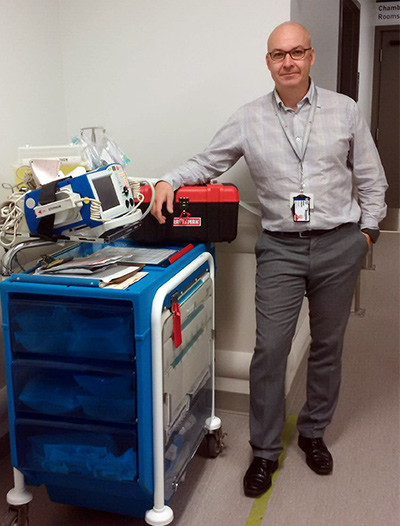November is CPR Awareness Month
 At the McGill University Health Centre (MUHC), there are more than 600 Code Blue activations a year. The activation varies from a false alert to a full cardiac arrest. They can happen anywhere at any time, so the Scout’s and Guide’s motto, Be Prepared, is what our teams stand by. At the MUHC, Code Blue carts are strategically placed and every team is always ready when activated to respond to the situation.
At the McGill University Health Centre (MUHC), there are more than 600 Code Blue activations a year. The activation varies from a false alert to a full cardiac arrest. They can happen anywhere at any time, so the Scout’s and Guide’s motto, Be Prepared, is what our teams stand by. At the MUHC, Code Blue carts are strategically placed and every team is always ready when activated to respond to the situation.
“A Code Blue is generally used to indicate a patient requiring resuscitation or who is in need of immediate medical attention, most often as the result of a respiratory distress or cardiac arrest,” says Michel Sergerie, MUHC clinical nurse specialist in Cardiology.
When someone falls within the MUHC, the closest healthcare professional knows to acknowledge the event and then to do a rapid evaluation: is he/she responding, is there circulation (compression), is there an airway obstruction and is he/she breathing? Following these parameters, the healthcare professional will activate a Code Blue (adult or pediatric).
Modern Day CPR
Over the years, with the use of research and evolving guidelines in resuscitation, CPR and defibrillation became the crucial element in the resuscitation process. CPR evolved progressively from 2005, 2010 up to the new 2015 guidelines, just published. CPR is distinct to each population (adult and pediatric). For more information, click here.
If CPR is required it will be started immediately and when the Code Blue team arrives they will take over the responsibilities. Within 10 minutes the code team should be able to see what is going on with the patient. There are then two ways to admit the patient to the hospital. If he/she is not an admitted patient already, the patient will be transferred either to the pediatric or adult emergency department. If he/she is an admitted patient, they are either admitted to the Cardiac Care Unit (CCU) or the Intensive Care Unit (ICU) or Pediatric ICU for recovery.
In all Code Blue adult and pediatric carts there is emergency medication, equipment to intubate the patient, a defibrillator, blood pressure cuffs, IV access devices and a glucometer to name a few of the essential items in the mobile tool box. At the Glen site of the MUHC, the adult and pediatric teams have the appropriate equipment to respond to either population when required.
 “When we have a code on the MCH or adult side of the Glen site, the model that we chose is who is closest responds,” says Sergerie. “For example, if there is an adult coding in the pediatric environment the code blue pediatric team will respond. If they cannot manage the situation they will activate the adult code blue team for additional support. It is vice versa if there is a child coding in the adult side.”
“When we have a code on the MCH or adult side of the Glen site, the model that we chose is who is closest responds,” says Sergerie. “For example, if there is an adult coding in the pediatric environment the code blue pediatric team will respond. If they cannot manage the situation they will activate the adult code blue team for additional support. It is vice versa if there is a child coding in the adult side.”
Sergerie’s message to everyone is: “Get CPR certified; you never know when you can help save a life.”
